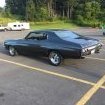-
Posts
870 -
Joined
-
Last visited
Reputation Activity
-
 newbuilder101 got a reaction from druxey in San Felipe by newbuilder101 (Sherry) – Scale 1:96
newbuilder101 got a reaction from druxey in San Felipe by newbuilder101 (Sherry) – Scale 1:96
Mark: As they say, necessity is the mother of invention - or in my case the mother of scrounging.
-
 newbuilder101 got a reaction from druxey in San Felipe by newbuilder101 (Sherry) – Scale 1:96
newbuilder101 got a reaction from druxey in San Felipe by newbuilder101 (Sherry) – Scale 1:96
I knew I had forgotten something. The trunnions are made from something very unusual. I just happened to have a selection of gramophone needles which are the perfect scale for my cannons.
-
 newbuilder101 got a reaction from Duanelaker in San Felipe by newbuilder101 (Sherry) – Scale 1:96
newbuilder101 got a reaction from Duanelaker in San Felipe by newbuilder101 (Sherry) – Scale 1:96
Thank-you everyone for the well wishes! My eye is healing quite nicely.
I've put together a very basic mini tutorial and hope it may be of help to someone.
I bought a brass turned cannon, of the correct scale for my ship, to use as a reference model.
I had a piece of round plastic dowel on hand, which I carved and sanded until it was the same size as the reference model.
Next, I cut paper trapezoids and rolled them around the plastic dowel, and sealed with some white glue. The dowel ensured that all my cannons would be the same.
Next up, I marked the location for each ring, by comparing to the reference model and cut very thin strips of paper and glued them in place. This can be tricky since the paper tube is narrow at one end and the strip naturally wants to spiral up the tube.
The cascabels/miniature mushrooms , were fashioned from polymer clay, then baked and glued in place. I had tried carving them from a wood dowel, but decided that clay would be a faster option.
At this point the "bore" was added. I dipped a toothpick in white glue and applied a thin film around the inside of the end of the cannon. Once dry I repeated once or twice more as needed.
This picture is a repeat from my last update, but it gives a good idea of the different stages.
Finally, a couple of thin layers of flat black acrylic were added and allowed to dry, followed by dry-brushing with yellow-ochre that was tamed down with a little brown.
This last picture shows the finished paper cannon beside the original brass cannon, which I also painted.
If you have any questions, please feel free to ask.
-
 newbuilder101 got a reaction from DORIS in San Felipe by newbuilder101 (Sherry) – Scale 1:96
newbuilder101 got a reaction from DORIS in San Felipe by newbuilder101 (Sherry) – Scale 1:96
Thank-you everyone for the well wishes! My eye is healing quite nicely.
I've put together a very basic mini tutorial and hope it may be of help to someone.
I bought a brass turned cannon, of the correct scale for my ship, to use as a reference model.
I had a piece of round plastic dowel on hand, which I carved and sanded until it was the same size as the reference model.
Next, I cut paper trapezoids and rolled them around the plastic dowel, and sealed with some white glue. The dowel ensured that all my cannons would be the same.
Next up, I marked the location for each ring, by comparing to the reference model and cut very thin strips of paper and glued them in place. This can be tricky since the paper tube is narrow at one end and the strip naturally wants to spiral up the tube.
The cascabels/miniature mushrooms , were fashioned from polymer clay, then baked and glued in place. I had tried carving them from a wood dowel, but decided that clay would be a faster option.
At this point the "bore" was added. I dipped a toothpick in white glue and applied a thin film around the inside of the end of the cannon. Once dry I repeated once or twice more as needed.
This picture is a repeat from my last update, but it gives a good idea of the different stages.
Finally, a couple of thin layers of flat black acrylic were added and allowed to dry, followed by dry-brushing with yellow-ochre that was tamed down with a little brown.
This last picture shows the finished paper cannon beside the original brass cannon, which I also painted.
If you have any questions, please feel free to ask.
-
 newbuilder101 reacted to Shazmira in US Brig Syren by Shazmira - Model Shipways - 1:64
newbuilder101 reacted to Shazmira in US Brig Syren by Shazmira - Model Shipways - 1:64
I apologize for my absence. I have been here, just not building atm. I had to deal with my mother's illness and subsequent death, and now the ship yard is in the process of being built, but at the same I am gutting the 100 y/o farm house we bought. Doing this room by room, kitchen is in the process now, and as I wait for things like sheet rock mud to dry etc, I step into the dry dock to get it built. Tough to do while working 60-70 hours a week. I still check in everyone's builds, and occasionally make a comment or two, but that is the best I can give right now.
-
 newbuilder101 reacted to mtaylor in San Felipe by newbuilder101 (Sherry) – Scale 1:96
newbuilder101 reacted to mtaylor in San Felipe by newbuilder101 (Sherry) – Scale 1:96
Gramophone needles? I think I've seen it all now. Very ingenious I must admit.
-
 newbuilder101 reacted to popeye the sailor in San Felipe by newbuilder101 (Sherry) – Scale 1:96
newbuilder101 reacted to popeye the sailor in San Felipe by newbuilder101 (Sherry) – Scale 1:96
I think you covered it quite nicely Sherry! very well done tutorial!
-
 newbuilder101 got a reaction from tadheus in San Felipe by newbuilder101 (Sherry) – Scale 1:96
newbuilder101 got a reaction from tadheus in San Felipe by newbuilder101 (Sherry) – Scale 1:96
Thank-you everyone for the well wishes! My eye is healing quite nicely.
I've put together a very basic mini tutorial and hope it may be of help to someone.
I bought a brass turned cannon, of the correct scale for my ship, to use as a reference model.
I had a piece of round plastic dowel on hand, which I carved and sanded until it was the same size as the reference model.
Next, I cut paper trapezoids and rolled them around the plastic dowel, and sealed with some white glue. The dowel ensured that all my cannons would be the same.
Next up, I marked the location for each ring, by comparing to the reference model and cut very thin strips of paper and glued them in place. This can be tricky since the paper tube is narrow at one end and the strip naturally wants to spiral up the tube.
The cascabels/miniature mushrooms , were fashioned from polymer clay, then baked and glued in place. I had tried carving them from a wood dowel, but decided that clay would be a faster option.
At this point the "bore" was added. I dipped a toothpick in white glue and applied a thin film around the inside of the end of the cannon. Once dry I repeated once or twice more as needed.
This picture is a repeat from my last update, but it gives a good idea of the different stages.
Finally, a couple of thin layers of flat black acrylic were added and allowed to dry, followed by dry-brushing with yellow-ochre that was tamed down with a little brown.
This last picture shows the finished paper cannon beside the original brass cannon, which I also painted.
If you have any questions, please feel free to ask.
-
 newbuilder101 reacted to augie in San Felipe by newbuilder101 (Sherry) – Scale 1:96
newbuilder101 reacted to augie in San Felipe by newbuilder101 (Sherry) – Scale 1:96
I've been asked 'Paper or Plastic' but, until now, never 'Paper or Brass? I can't tell the difference !!!!!
Could you mention how you made the trunnions?
-
 newbuilder101 got a reaction from Trafalgarhero in San Felipe by newbuilder101 (Sherry) – Scale 1:96
newbuilder101 got a reaction from Trafalgarhero in San Felipe by newbuilder101 (Sherry) – Scale 1:96
Thank-you everyone for the well wishes! My eye is healing quite nicely.
I've put together a very basic mini tutorial and hope it may be of help to someone.
I bought a brass turned cannon, of the correct scale for my ship, to use as a reference model.
I had a piece of round plastic dowel on hand, which I carved and sanded until it was the same size as the reference model.
Next, I cut paper trapezoids and rolled them around the plastic dowel, and sealed with some white glue. The dowel ensured that all my cannons would be the same.
Next up, I marked the location for each ring, by comparing to the reference model and cut very thin strips of paper and glued them in place. This can be tricky since the paper tube is narrow at one end and the strip naturally wants to spiral up the tube.
The cascabels/miniature mushrooms , were fashioned from polymer clay, then baked and glued in place. I had tried carving them from a wood dowel, but decided that clay would be a faster option.
At this point the "bore" was added. I dipped a toothpick in white glue and applied a thin film around the inside of the end of the cannon. Once dry I repeated once or twice more as needed.
This picture is a repeat from my last update, but it gives a good idea of the different stages.
Finally, a couple of thin layers of flat black acrylic were added and allowed to dry, followed by dry-brushing with yellow-ochre that was tamed down with a little brown.
This last picture shows the finished paper cannon beside the original brass cannon, which I also painted.
If you have any questions, please feel free to ask.
-
 newbuilder101 got a reaction from edmay in San Felipe by newbuilder101 (Sherry) – Scale 1:96
newbuilder101 got a reaction from edmay in San Felipe by newbuilder101 (Sherry) – Scale 1:96
Okay Robbyn and Bob, I'll see what I can do. It will have to wait for a day or two since I need just a little time to recover from eye surgery. If I do it now with one good eye, the tutorial may be a bit "wonky".
-
 newbuilder101 got a reaction from Adrieke in San Felipe by newbuilder101 (Sherry) – Scale 1:96
newbuilder101 got a reaction from Adrieke in San Felipe by newbuilder101 (Sherry) – Scale 1:96
Thank-you everyone for the well wishes! My eye is healing quite nicely.
I've put together a very basic mini tutorial and hope it may be of help to someone.
I bought a brass turned cannon, of the correct scale for my ship, to use as a reference model.
I had a piece of round plastic dowel on hand, which I carved and sanded until it was the same size as the reference model.
Next, I cut paper trapezoids and rolled them around the plastic dowel, and sealed with some white glue. The dowel ensured that all my cannons would be the same.
Next up, I marked the location for each ring, by comparing to the reference model and cut very thin strips of paper and glued them in place. This can be tricky since the paper tube is narrow at one end and the strip naturally wants to spiral up the tube.
The cascabels/miniature mushrooms , were fashioned from polymer clay, then baked and glued in place. I had tried carving them from a wood dowel, but decided that clay would be a faster option.
At this point the "bore" was added. I dipped a toothpick in white glue and applied a thin film around the inside of the end of the cannon. Once dry I repeated once or twice more as needed.
This picture is a repeat from my last update, but it gives a good idea of the different stages.
Finally, a couple of thin layers of flat black acrylic were added and allowed to dry, followed by dry-brushing with yellow-ochre that was tamed down with a little brown.
This last picture shows the finished paper cannon beside the original brass cannon, which I also painted.
If you have any questions, please feel free to ask.
-
 newbuilder101 got a reaction from egkb in San Felipe by newbuilder101 (Sherry) – Scale 1:96
newbuilder101 got a reaction from egkb in San Felipe by newbuilder101 (Sherry) – Scale 1:96
Thank-you everyone for the well wishes! My eye is healing quite nicely.
I've put together a very basic mini tutorial and hope it may be of help to someone.
I bought a brass turned cannon, of the correct scale for my ship, to use as a reference model.
I had a piece of round plastic dowel on hand, which I carved and sanded until it was the same size as the reference model.
Next, I cut paper trapezoids and rolled them around the plastic dowel, and sealed with some white glue. The dowel ensured that all my cannons would be the same.
Next up, I marked the location for each ring, by comparing to the reference model and cut very thin strips of paper and glued them in place. This can be tricky since the paper tube is narrow at one end and the strip naturally wants to spiral up the tube.
The cascabels/miniature mushrooms , were fashioned from polymer clay, then baked and glued in place. I had tried carving them from a wood dowel, but decided that clay would be a faster option.
At this point the "bore" was added. I dipped a toothpick in white glue and applied a thin film around the inside of the end of the cannon. Once dry I repeated once or twice more as needed.
This picture is a repeat from my last update, but it gives a good idea of the different stages.
Finally, a couple of thin layers of flat black acrylic were added and allowed to dry, followed by dry-brushing with yellow-ochre that was tamed down with a little brown.
This last picture shows the finished paper cannon beside the original brass cannon, which I also painted.
If you have any questions, please feel free to ask.
-
 newbuilder101 got a reaction from druxey in San Felipe by newbuilder101 (Sherry) – Scale 1:96
newbuilder101 got a reaction from druxey in San Felipe by newbuilder101 (Sherry) – Scale 1:96
Thank-you everyone for the well wishes! My eye is healing quite nicely.
I've put together a very basic mini tutorial and hope it may be of help to someone.
I bought a brass turned cannon, of the correct scale for my ship, to use as a reference model.
I had a piece of round plastic dowel on hand, which I carved and sanded until it was the same size as the reference model.
Next, I cut paper trapezoids and rolled them around the plastic dowel, and sealed with some white glue. The dowel ensured that all my cannons would be the same.
Next up, I marked the location for each ring, by comparing to the reference model and cut very thin strips of paper and glued them in place. This can be tricky since the paper tube is narrow at one end and the strip naturally wants to spiral up the tube.
The cascabels/miniature mushrooms , were fashioned from polymer clay, then baked and glued in place. I had tried carving them from a wood dowel, but decided that clay would be a faster option.
At this point the "bore" was added. I dipped a toothpick in white glue and applied a thin film around the inside of the end of the cannon. Once dry I repeated once or twice more as needed.
This picture is a repeat from my last update, but it gives a good idea of the different stages.
Finally, a couple of thin layers of flat black acrylic were added and allowed to dry, followed by dry-brushing with yellow-ochre that was tamed down with a little brown.
This last picture shows the finished paper cannon beside the original brass cannon, which I also painted.
If you have any questions, please feel free to ask.
-
 newbuilder101 got a reaction from u21rw87 in San Felipe by newbuilder101 (Sherry) – Scale 1:96
newbuilder101 got a reaction from u21rw87 in San Felipe by newbuilder101 (Sherry) – Scale 1:96
Thank-you everyone for the well wishes! My eye is healing quite nicely.
I've put together a very basic mini tutorial and hope it may be of help to someone.
I bought a brass turned cannon, of the correct scale for my ship, to use as a reference model.
I had a piece of round plastic dowel on hand, which I carved and sanded until it was the same size as the reference model.
Next, I cut paper trapezoids and rolled them around the plastic dowel, and sealed with some white glue. The dowel ensured that all my cannons would be the same.
Next up, I marked the location for each ring, by comparing to the reference model and cut very thin strips of paper and glued them in place. This can be tricky since the paper tube is narrow at one end and the strip naturally wants to spiral up the tube.
The cascabels/miniature mushrooms , were fashioned from polymer clay, then baked and glued in place. I had tried carving them from a wood dowel, but decided that clay would be a faster option.
At this point the "bore" was added. I dipped a toothpick in white glue and applied a thin film around the inside of the end of the cannon. Once dry I repeated once or twice more as needed.
This picture is a repeat from my last update, but it gives a good idea of the different stages.
Finally, a couple of thin layers of flat black acrylic were added and allowed to dry, followed by dry-brushing with yellow-ochre that was tamed down with a little brown.
This last picture shows the finished paper cannon beside the original brass cannon, which I also painted.
If you have any questions, please feel free to ask.
-
 newbuilder101 got a reaction from DORIS in San Felipe by newbuilder101 (Sherry) – Scale 1:96
newbuilder101 got a reaction from DORIS in San Felipe by newbuilder101 (Sherry) – Scale 1:96
Thank-you everyone for all the comments!
Well, an update is long overdue - I almost feel I should introduce myself again!
I struggled in the summer with which route to take for my cannons. I tried making molds and casting with resin with only limited success. The summer flew by and winter appeared and casting became a problem due to mess and allergies, or at least some reaction to the fumes. Ideally working outside is the best option, but at -20 degrees Celsius, it's not an option!
I had seen some paper cannons that Doris made and I thought I would give that a try. It would be easier if my scale was larger, but I don't find it too difficult. I know they are not perfect, but I am relatively pleased with the outcome and will continue with this process.
I am currently experimenting with weathering the cannons, so the painted one is not necessarily what the finished product will look like.
-
 newbuilder101 reacted to mtaylor in San Felipe by newbuilder101 (Sherry) – Scale 1:96
newbuilder101 reacted to mtaylor in San Felipe by newbuilder101 (Sherry) – Scale 1:96
Take care of the eyes, Sherry. The ship and tutorial can wait.
-
 newbuilder101 reacted to captainbob in San Felipe by newbuilder101 (Sherry) – Scale 1:96
newbuilder101 reacted to captainbob in San Felipe by newbuilder101 (Sherry) – Scale 1:96
We can wait. Your eyes are more important than a tutorial.
Bob
-
 newbuilder101 reacted to augie in San Felipe by newbuilder101 (Sherry) – Scale 1:96
newbuilder101 reacted to augie in San Felipe by newbuilder101 (Sherry) – Scale 1:96
Sorry to hear about the surgery, Sherry. We'll keep our fingers crossed for a complete and rapid recovery. Follow the Dr.'s orders !
-
 newbuilder101 reacted to popeye the sailor in San Felipe by newbuilder101 (Sherry) – Scale 1:96
newbuilder101 reacted to popeye the sailor in San Felipe by newbuilder101 (Sherry) – Scale 1:96
recover well...Sherry
-
 newbuilder101 reacted to Elia in San Felipe by newbuilder101 (Sherry) – Scale 1:96
newbuilder101 reacted to Elia in San Felipe by newbuilder101 (Sherry) – Scale 1:96
Get well soon!
Cheers
Elia
-
 newbuilder101 reacted to Omega1234 in San Felipe by newbuilder101 (Sherry) – Scale 1:96
newbuilder101 reacted to Omega1234 in San Felipe by newbuilder101 (Sherry) – Scale 1:96
Hi Sherry
Eye surgery!!! Hope all's well.
Cheers
Patrick
-
 newbuilder101 reacted to augie in HMS Agamemnon by Sjors - FINISHED - Caldercraft/Jotika - 1:64
newbuilder101 reacted to augie in HMS Agamemnon by Sjors - FINISHED - Caldercraft/Jotika - 1:64
Mobbsie has made a great suggestion. Don't ask me how I know this!
-
 newbuilder101 reacted to Gaetan Bordeleau in Le Fleuron by Gaetan Bordeleau - FINISHED - 1:24
newbuilder101 reacted to Gaetan Bordeleau in Le Fleuron by Gaetan Bordeleau - FINISHED - 1:24
The next parts will be under the balcony.
General height to work on a table is 30 inches. To work, especially on small parts, 30 inches is far from being ideal height, it is often too low; easy solution; adjustable height table, electric or by hand or even at lower price in the used. If I would have known before this is the kind of tool I would have bought a lot sooner.
-
 newbuilder101 reacted to Dan Vadas in HMS Vulture 1776 by Dan Vadas - FINISHED - 1:48 scale - 16-gun Swan-class sloop from TFFM plans
newbuilder101 reacted to Dan Vadas in HMS Vulture 1776 by Dan Vadas - FINISHED - 1:48 scale - 16-gun Swan-class sloop from TFFM plans
Main Topmast Stays
There is a preventer stay as well as a main stay for the topmast. These were made in similar fashion to the mizzen topmast stay. There is a Violin block attached to the lower end. I made these from one piece of stock the same way I make the Sister blocks :
The stays are served where they go around the mast head and for a few scale feet below the mouse. A Collar is used to hold a lead block to the mast. The preventer stay block is fitted just below the foremast hounds. This would have been considerably easier to fit on the bench before I'd fitted the mast top :
Here are a few pics of the main topmast stay ready for fitting :
And some more of both stays fitted. The preventer stay goes on first :
The lead block for the main topmast stay has a collar which could be slipped over the fore mast head. This pic was taken well after I'd fitted the stay - the fore topmast and shrouds had been fitted when I took the pic :
The sister blocks and their tackle at the foot of the fore mast. Hooks are used to attach the lower blocks to the eyebolts in the deck :
Danny










